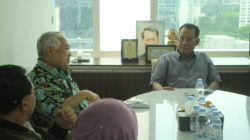Hafid Abbas
Chairman of the Senate Board of Universitas Negeri Jakarta
On July 18, 2022, Prof. Dr. Agus Dudung MPd, in his inauguration as a Permanent Professor in the field of Vocational Learning Evaluation at the Faculty of Engineering, UNJ, presented his scientific oration with the title “Student Graduate Achievement: Three-E (E-Readiness, E-Learning, and E-Books).
Dudung’s statement about the employment of digital technology in the form of e-learning appears to be highly relevant, especially during and after the COVID-19 epidemic. Students can easily use Three-E as an electronic learning medium, which uses information and communication technology (ICT)-based information packages for learning objectives. According to Dudung, the usage of this medium can produce a more favorable, effective, and efficient learning environment that fosters graduate success and achievement.
With all due respect, the Covid-19 pandemic that has ravaged Indonesia over the last 2-3 years has had a severe impact on the country’s educational system. On April 30, 2022, there were 6,046,796 instances of the Covid-19 pandemic, the second most in ASEAN behind Vietnam. Indonesia has the second greatest number of fatalities in Asia and the ninth most in the world, with 156,257 deaths (Covid-19 Databased, 2020).
According to UNESCO and UNICEF (2020), Covid-19 has widened the difference in educational quality between Java and outside Java, public and private, cities and villages, and so on. During the harvest period, all schools and learning facilities in the community were shuttered, resulting in an estimated 68 million youngsters losing access to education. The only way out of this dilemma is to replace it with online education. However, 67 percent of teachers still have trouble using digital devices and e-learning learning media, and four out of every five internet connections in Indonesia are in Java and Sumatra.
Overview of the Utilization of e-Learning in various countries
Taking into account the data on the impact of the Covid-19 pandemic on the world of education, from the results of his meta-analysis of a number of related studies, Dudung showed that the role of Three-E contributed 32.40% to the achievement of student graduates.
As a comparison of Dudung’s findings, we find an interesting study in the application of digital technology in private universities in Malaysia on the use of e-learning in the entire scope of its tri-dharma activities. It was revealed that the implementation of e-learning that was integrated with academic activities was actually driven by young lecturers. They are considered more innovative and proactive towards change compared to senior lecturers. They are on average 25-35 years old, have master’s degree education with 2-5 years of work experience, work full time, and they are considered to be more accomplished than seniors in software preparation website and so on. Senior lecturers tend to maintain a comfort zone, and are suspicious and suspicious of change (Sukumaran, University of Malaya, 2016).
Another study, the OECD in its publication E-Learning in Higher Education in Latin America (2015) assessed that universities (PT) are the driving force of socio-economic progress and a key factor in realizing inclusive and sustainable development in Latin America (AL) and the Caribbean. This study reveals its various findings on the implementation of e-learning in 341 universities spread across 13 countries in the Navy region. It founds that 65% PT still conduct face-to-face lectures; 16% combine face-to-face with e-learning (hybrid); and 19% online.
Furthermore, this OECD research shows: e-learning not been recognized nationally, except in only a third of universities in 34 countries because their quality is considered low; courses online required by the market; and, 38% of PTs did not prepare investment costs related to the preparation of e-leaning, and 25% did not prepare their operating budget at all.
Furthermore, between 2013 and 2018, the Navy’s use of e-learning surged by 9.7 percent, more than double the global average (4.4 percent), and even higher than in Asia (8.9 percent ). The highest rates were found in Africa (16.4%), Eastern Europe (8.4%), and the Middle East (6.3%).
Meanwhile, the cost of gaining access to ICT is measured by per capita income; the US is 0.4%, Canada is 1.1%, and in the Navy the figures vary widely (from 1.5% in Uruguay, 2% in Brazil, and 22.8% in the United States). In Haiti, the figure is 81.9% (ITU, 2012). The use of e-learning in the Navy looks like very extreme inequality (digital divide).
This inequality is similar to the situation between regions in Indonesia. Java and Sumatra account for four out of every five internet connections in Indonesia (UNESCO, 2020). The cost of getting internet access in Papua is certainly much more expensive than in Java, because the ICT technology infrastructure is not evenly distributed. Not only that, it was reported by the World Bank in Indonesia Rising Divide (2015) that children’s access to proper sanitation facilities in schools has reached 94%, while in Papua it is only 2% (p. ii).
Finally, another study on e-learning conducted by the Technological University Dublin in Ireland (2012) found that: 90% of students rated e-learning as having a positive impact on them; 80% assume e-learning is fun and interesting; and 75% assume e-learning has increased their interest in furthering their studies. Furthermore, 70% of students believed that lecturers’ roles should be prioritized, with e-learning serving as a supplement; and even 80% of students believed that attending lectures in class face-to-face makes it easier to understand the content of the lecture because questions can be directed directly to the lecturer.
Hopefully, Indonesia will soon catch up with Malaysia and other ASEAN neighbors in the use of digital-based educational technology such as e-learning.










